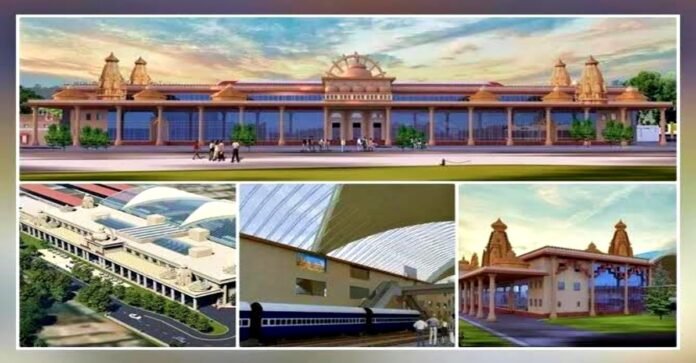
Ayodhya: The holy city of Ayodhya, which is gearing up for the inauguration of the Ram Temple by Prime Minister Narendra Modi on January 22, 2024, has a new landmark in the form of Ayodhya Dham Junction. The railway station, formerly known as Ayodhya Junction, has been renamed and revamped by the Indian Railways, in collaboration with the Uttar Pradesh government, to reflect the cultural and spiritual significance of the city.
The development of the station is planned to occur in three phases, with an estimated cost of Rs. 104 crore. The first phase, which has been completed ahead of the inauguration by PM Modi on December 30, 2023, has transformed the station into a state-of-the-art facility, with a host of amenities and features for the passengers.
One of the most striking aspects of the station is its architectural design, which is inspired by the Ram Temple. The station building, which has a built-up area of 1,116 square meters, has a dome-shaped roof, arched windows, and pillars adorned with carvings. The stones used for the construction of the station were sourced from the same quarry in the Bansi Paharpur area of Bharatpur district of Rajasthan, from where the stones for the Ram Temple were brought. The station also has a mural depicting the Ramayana on its facade, along with the name of the station in Hindi, English, and Urdu.
The station boasts of having the country’s largest concourse, with a capacity of 10,000 passengers. The concourse, which has a built-up area of 2,000 square meters, has a spacious waiting area, a food plaza, a cloakroom, a tourist information center, a passenger facilities desk, and a sick room. The sick room, which is equipped with a bed, a stretcher, and a first-aid kit, is meant to provide medical assistance to passengers who may fall ill or get injured during their journey. The tourist information center and the passenger facilities desk provide information about the various spiritual and tourist attractions in and around Ayodhya, such as the Ram Temple, the Ram Janmabhoomi, the Hanuman Garhi, the Saryu River, and the Nageshwar Nath Temple, as well as the modes of transport and accommodation available.
The station also has several other facilities to ensure the comfort and convenience of the passengers, such as toilets, drinking water stations, escalators, lifts, staircases, fire exits, shops, and staff rooms. The station has also taken care of the needs of the differently-abled passengers, by providing specially designed toilets, ramps, and wheelchairs. The station has a total of 12 platforms, which are connected by foot overbridges. The first floor of the station will also have additional facilities, such as a food plaza, a waiting hall, toilets, drinking water stations, escalators, lifts, staff rooms, shops, waiting rooms, and an entry footbridge.

The station, which is expected to witness a surge in footfall after the inauguration of the Ram Temple, is a symbol of the cultural and religious heritage of Ayodhya, as well as the modern and progressive vision of the Indian Railways. The station is not only a gateway to the holy city but also a destination in itself, for the pilgrims and tourists who visit Ayodhya.



















































